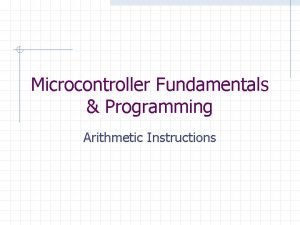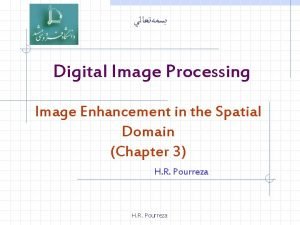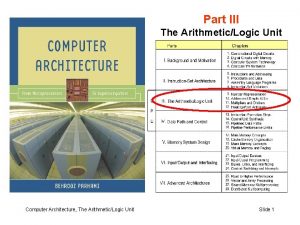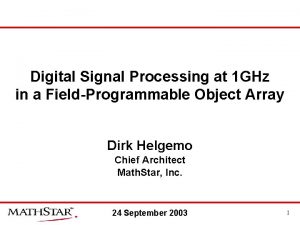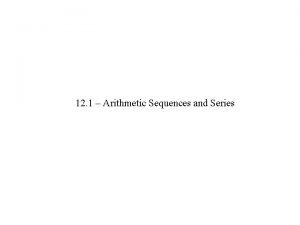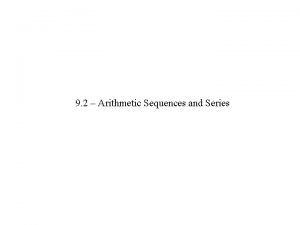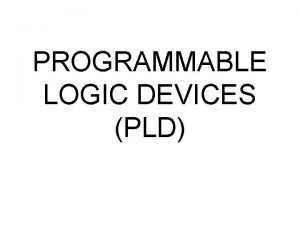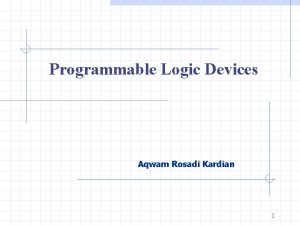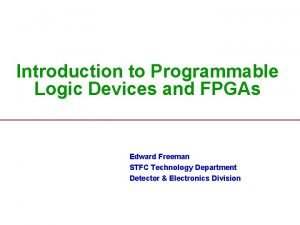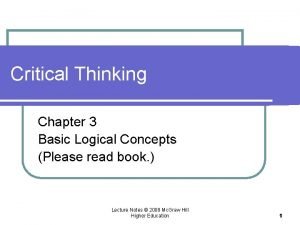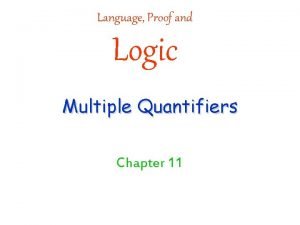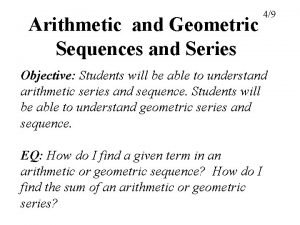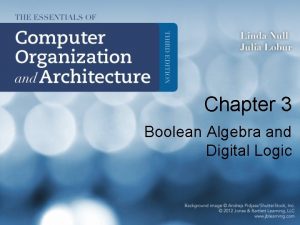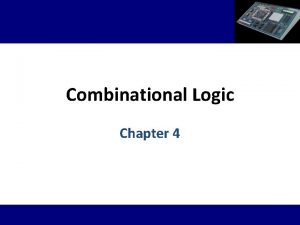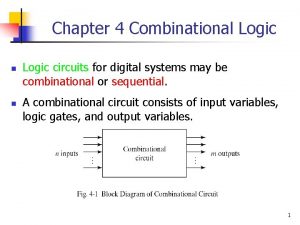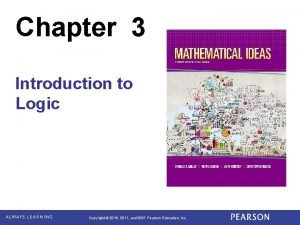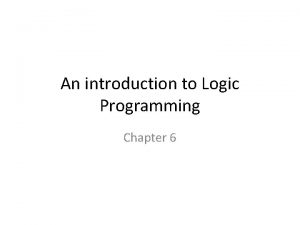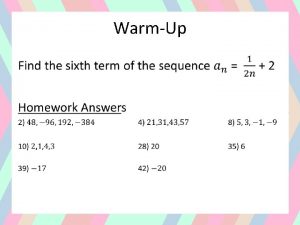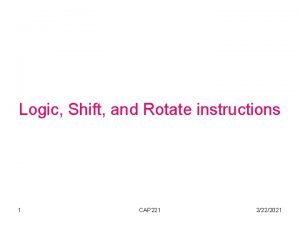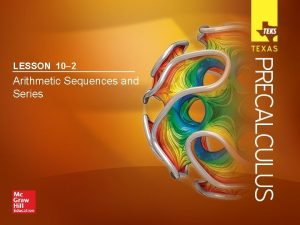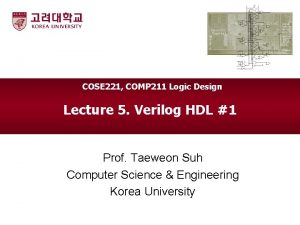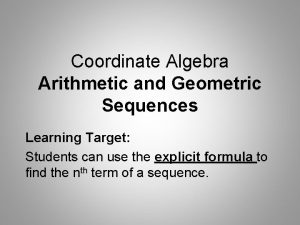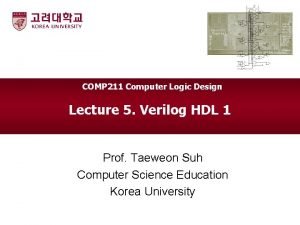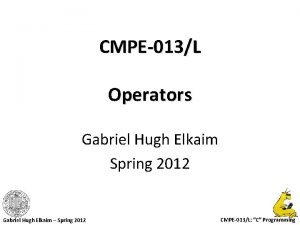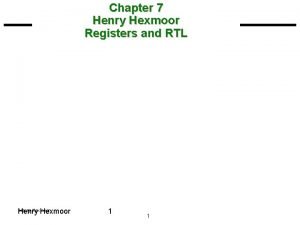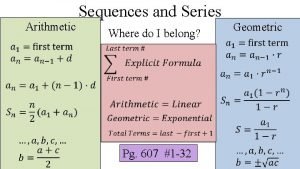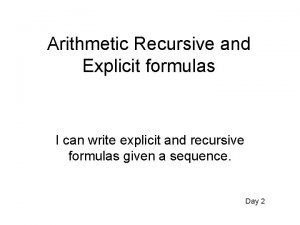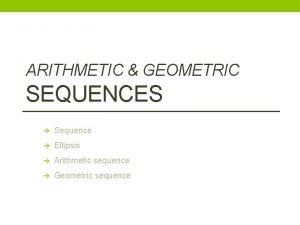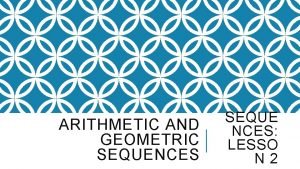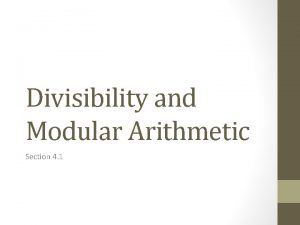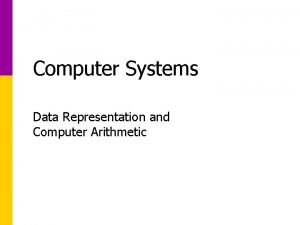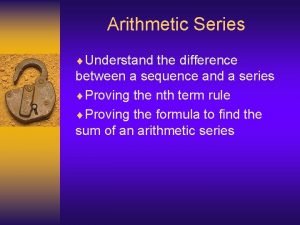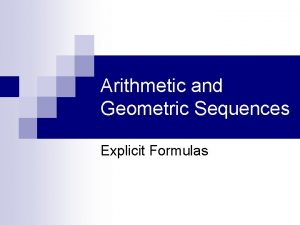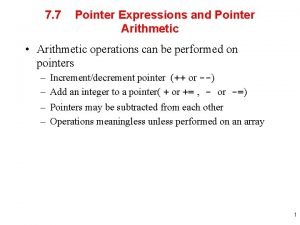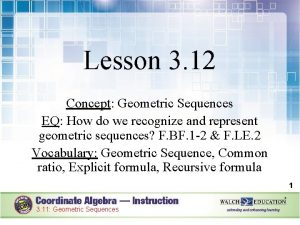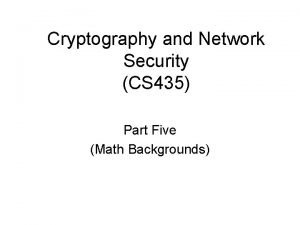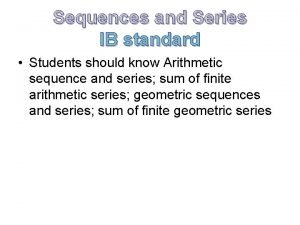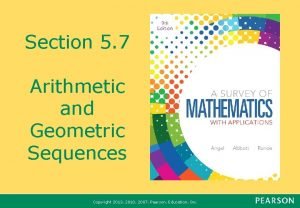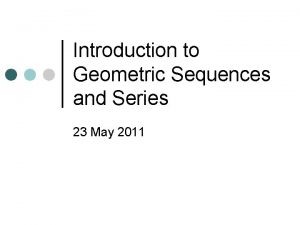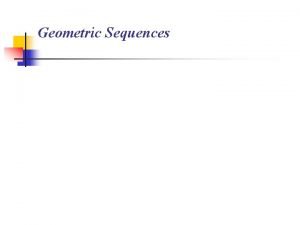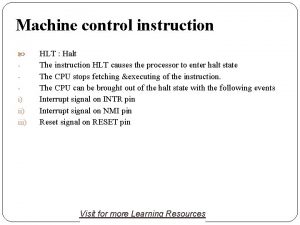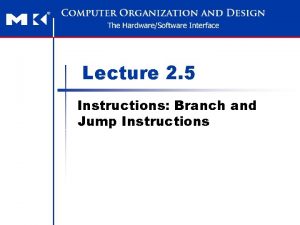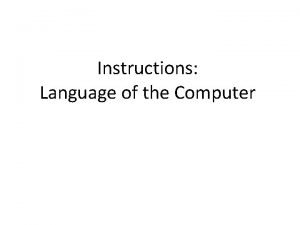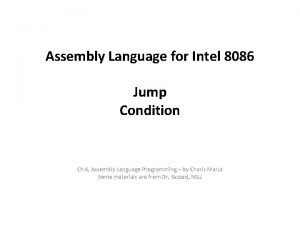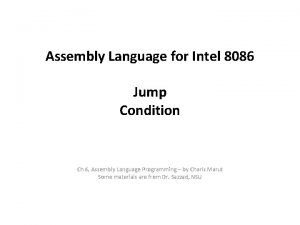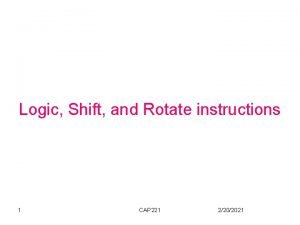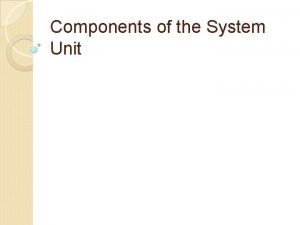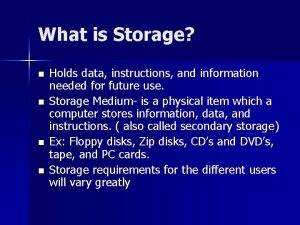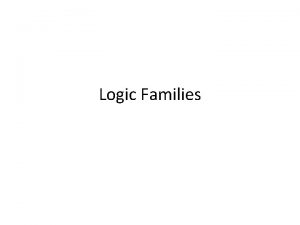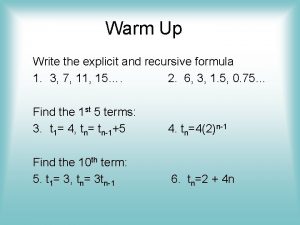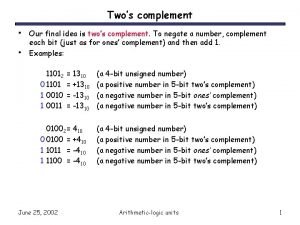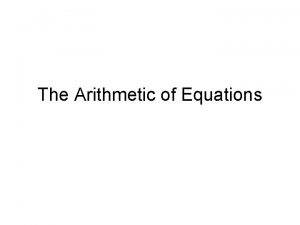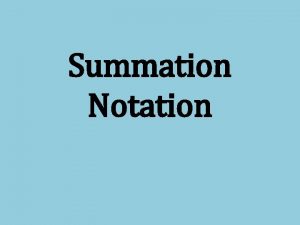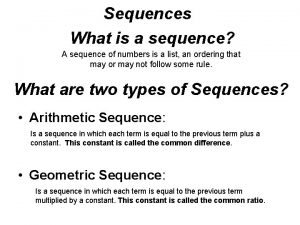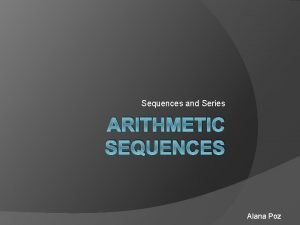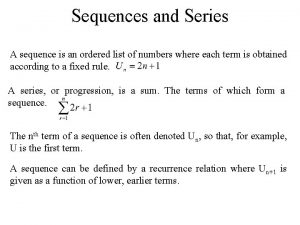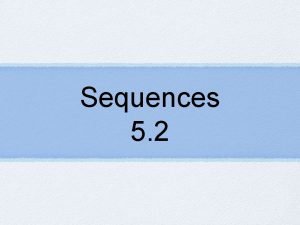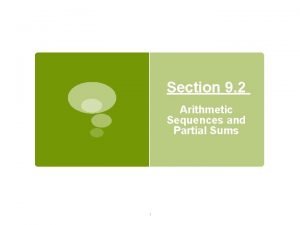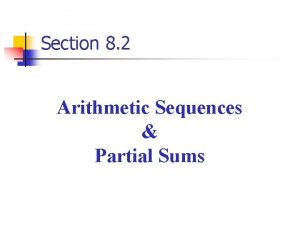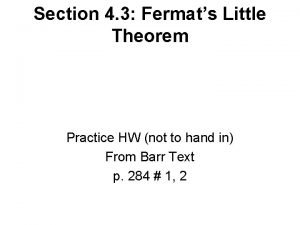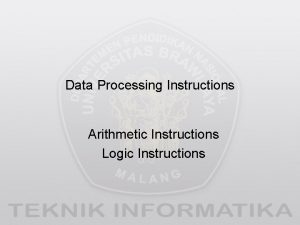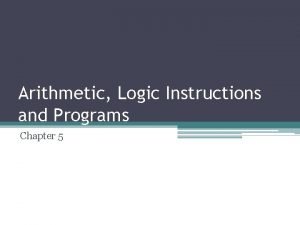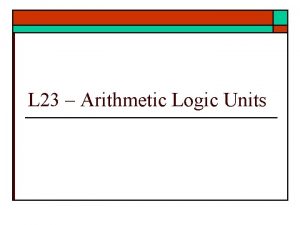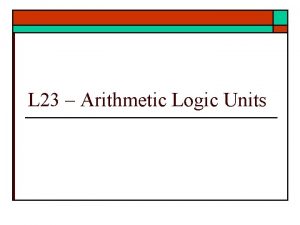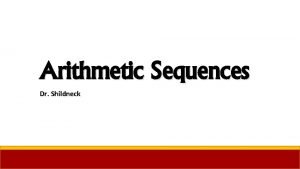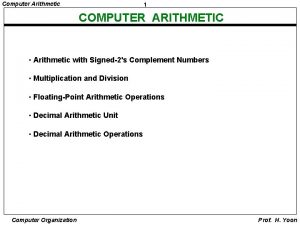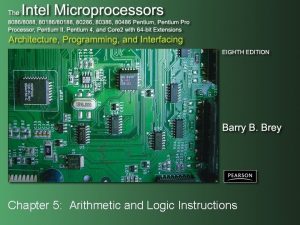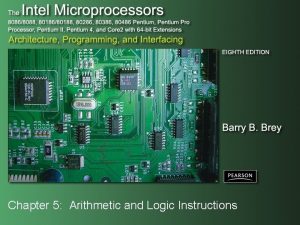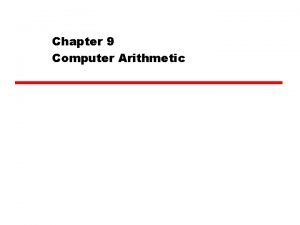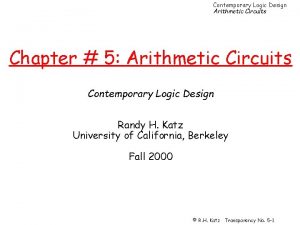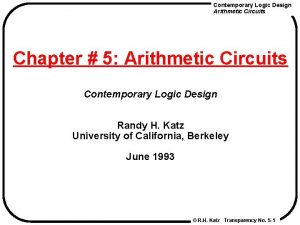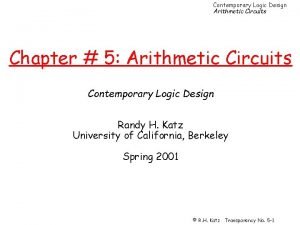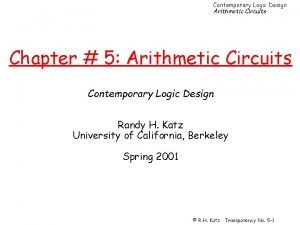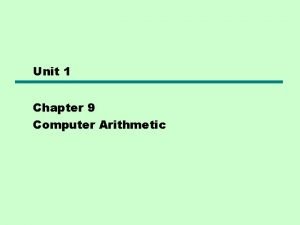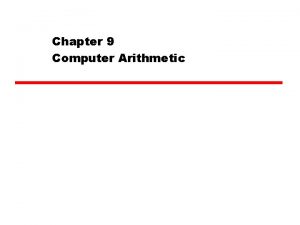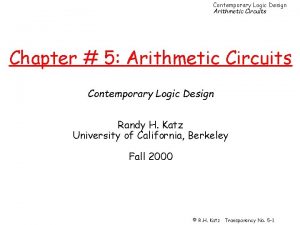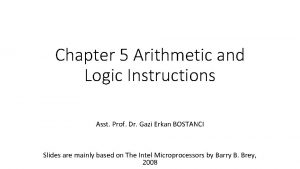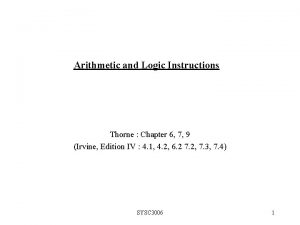Chapter 5 Arithmetic and Logic Instructions Introduction We























































































- Slides: 87

Chapter 5: Arithmetic and Logic Instructions

Introduction • We examine the arithmetic and logic instructions. The arithmetic instructions include addition, subtraction, multiplication, division, comparison, negation, increment, and decrement. • The logic instructions include AND, OR, Exclusive-OR, NOT, shifts, rotates, and the logical compare (TEST). The Intel Microprocessors: 8086/8088, 80186/80188, 80286, 80386, 80486 Pentium, Pentium Processor, Pentium II, Pentium, 4, and Core 2 with 64 -bit Extensions Architecture, Programming, and Interfacing, Eighth Edition Barry B. Brey Copyright © 2009 by Pearson Education, Inc. Upper Saddle River, New Jersey 07458 • All rights reserved.

Chapter Objectives Upon completion of this chapter, you will be able to: • Use arithmetic and logic instructions to accomplish simple binary, BCD, and ASCII arithmetic. • Use AND, OR, and Exclusive-OR to accomplish binary bit manipulation. • Use the shift and rotate instructions. The Intel Microprocessors: 8086/8088, 80186/80188, 80286, 80386, 80486 Pentium, Pentium Processor, Pentium II, Pentium, 4, and Core 2 with 64 -bit Extensions Architecture, Programming, and Interfacing, Eighth Edition Barry B. Brey Copyright © 2009 by Pearson Education, Inc. Upper Saddle River, New Jersey 07458 • All rights reserved.

Chapter Objectives (cont. ) Upon completion of this chapter, you will be able to: • Explain the operation of the 80386 through the Core 2 exchange and add, compare and exchange, double-precision shift, bit test, and bit scan instructions. • Check the contents of a table for a match with the string instructions. The Intel Microprocessors: 8086/8088, 80186/80188, 80286, 80386, 80486 Pentium, Pentium Processor, Pentium II, Pentium, 4, and Core 2 with 64 -bit Extensions Architecture, Programming, and Interfacing, Eighth Edition Barry B. Brey Copyright © 2009 by Pearson Education, Inc. Upper Saddle River, New Jersey 07458 • All rights reserved.

5 -1 ADDITION, SUBTRACTION AND COMPARISON • The bulk of the arithmetic instructions found in any microprocessor include addition, subtraction, and comparison. • Addition, subtraction, and comparison instructions are illustrated. • Also shown are their uses in manipulating register and memory data. The Intel Microprocessors: 8086/8088, 80186/80188, 80286, 80386, 80486 Pentium, Pentium Processor, Pentium II, Pentium, 4, and Core 2 with 64 -bit Extensions Architecture, Programming, and Interfacing, Eighth Edition Barry B. Brey Copyright © 2009 by Pearson Education, Inc. Upper Saddle River, New Jersey 07458 • All rights reserved.

Addition • Addition (ADD) appears in many forms in the microprocessor. • A second form of addition, called add-withcarry, is introduced with the ADC instruction. • The only types of addition not allowed are memory-to-memory and segment register. – segment registers can only be moved, pushed, or popped • Increment instruction (INC) is a special type of addition that adds 1 to a number. The Intel Microprocessors: 8086/8088, 80186/80188, 80286, 80386, 80486 Pentium, Pentium Processor, Pentium II, Pentium, 4, and Core 2 with 64 -bit Extensions Architecture, Programming, and Interfacing, Eighth Edition Barry B. Brey Copyright © 2009 by Pearson Education, Inc. Upper Saddle River, New Jersey 07458 • All rights reserved.

Register Addition • When arithmetic and logic instructions execute, contents of the flag register change. – interrupt, trap, and other flags do not change • Any ADD instruction modifies the contents of the sign, zero, carry, auxiliary carry, parity, and overflow flags. Immediate Addition • Immediate addition is employed whenever constant or known data are added. The Intel Microprocessors: 8086/8088, 80186/80188, 80286, 80386, 80486 Pentium, Pentium Processor, Pentium II, Pentium, 4, and Core 2 with 64 -bit Extensions Architecture, Programming, and Interfacing, Eighth Edition Barry B. Brey Copyright © 2009 by Pearson Education, Inc. Upper Saddle River, New Jersey 07458 • All rights reserved.

Memory-to-Register Addition • Moves memory data to be added to the AL (and other) register. Array Addition • Memory arrays are sequential lists of data. The Intel Microprocessors: 8086/8088, 80186/80188, 80286, 80386, 80486 Pentium, Pentium Processor, Pentium II, Pentium, 4, and Core 2 with 64 -bit Extensions Architecture, Programming, and Interfacing, Eighth Edition Barry B. Brey Copyright © 2009 by Pearson Education, Inc. Upper Saddle River, New Jersey 07458 • All rights reserved.

Array Addition • Sequential lists of data. • A sequence of instructions written 80386 shows scaled-index form addressing to add elements 3, 5, and 7 of an area of memory called ARRAY. • EBX is loaded with the address ARRAY, and ECX holds the array element number. • The scaling factor is used to multiply the contents of the ECX register by 2 to address words of data. The Intel Microprocessors: 8086/8088, 80186/80188, 80286, 80386, 80486 Pentium, Pentium Processor, Pentium II, Pentium, 4, and Core 2 with 64 -bit Extensions Architecture, Programming, and Interfacing, Eighth Edition Barry B. Brey Copyright © 2009 by Pearson Education, Inc. Upper Saddle River, New Jersey 07458 • All rights reserved.

Increment Addition • The INC instruction adds 1 to any register or memory location, except a segment register. • The size of the data must be described by using the BYTE PTR, WORD PTR, DWORD PTR, or QWORD PTR directives. • The assembler program cannot determine if the INC [DI] instruction is a byte-, word-, or doubleword-sized increment. The Intel Microprocessors: 8086/8088, 80186/80188, 80286, 80386, 80486 Pentium, Pentium Processor, Pentium II, Pentium, 4, and Core 2 with 64 -bit Extensions Architecture, Programming, and Interfacing, Eighth Edition Barry B. Brey Copyright © 2009 by Pearson Education, Inc. Upper Saddle River, New Jersey 07458 • All rights reserved.

Addition-with-Carry • ADC) adds the bit in the carry flag (C) to the operand data. – mainly appears in software that adds numbers wider than 16 or 32 bits in the 80386–Core 2 – like ADD, ADC affects the flags after the addition • Figure 5– 1 illustrates this so placement and function of the carry flag can be understood. – cannot be easily performed without adding the carry flag bit because the 8086– 80286 only adds 8 - or 16 -bit numbers The Intel Microprocessors: 8086/8088, 80186/80188, 80286, 80386, 80486 Pentium, Pentium Processor, Pentium II, Pentium, 4, and Core 2 with 64 -bit Extensions Architecture, Programming, and Interfacing, Eighth Edition Barry B. Brey Copyright © 2009 by Pearson Education, Inc. Upper Saddle River, New Jersey 07458 • All rights reserved.

Figure 5– 1 Addition-with-carry showing how the carry flag (C) links the two 16 -bit additions into one 32 -bit addition. The Intel Microprocessors: 8086/8088, 80186/80188, 80286, 80386, 80486 Pentium, Pentium Processor, Pentium II, Pentium, 4, and Core 2 with 64 -bit Extensions Architecture, Programming, and Interfacing, Eighth Edition Barry B. Brey Copyright © 2009 by Pearson Education, Inc. Upper Saddle River, New Jersey 07458 • All rights reserved.

Exchange and Add for the 80486– Core 2 Processors • Exchange and add (XADD) appears in 80486 and continues through the Core 2. • XADD instruction adds the source to the destination and stores the sum in the destination, as with any addition. – after the addition takes place, the original value of the destination is copied into the source operand • One of the few instructions that change the source. The Intel Microprocessors: 8086/8088, 80186/80188, 80286, 80386, 80486 Pentium, Pentium Processor, Pentium II, Pentium, 4, and Core 2 with 64 -bit Extensions Architecture, Programming, and Interfacing, Eighth Edition Barry B. Brey Copyright © 2009 by Pearson Education, Inc. Upper Saddle River, New Jersey 07458 • All rights reserved.

Subtraction • Many forms of subtraction (SUB) appear in the instruction set. – these use any addressing mode with 8 -, 16 -, or 32 bit data – a special form of subtraction (decrement, or DEC) subtracts 1 from any register or memory location • Numbers that are wider than 16 bits or 32 bits must occasionally be subtracted. – the subtract-with-borrow instruction (SBB) performs this type of subtraction The Intel Microprocessors: 8086/8088, 80186/80188, 80286, 80386, 80486 Pentium, Pentium Processor, Pentium II, Pentium, 4, and Core 2 with 64 -bit Extensions Architecture, Programming, and Interfacing, Eighth Edition Barry B. Brey Copyright © 2009 by Pearson Education, Inc. Upper Saddle River, New Jersey 07458 • All rights reserved.

Register Subtraction • After each subtraction, the microprocessor modifies the contents of the flag register. – flags change for most arithmetic/logic operations Immediate Subtraction • The microprocessor also allows immediate operands for the subtraction of constant data. Decrement Subtraction • Subtracts 1 from a register/memory location. The Intel Microprocessors: 8086/8088, 80186/80188, 80286, 80386, 80486 Pentium, Pentium Processor, Pentium II, Pentium, 4, and Core 2 with 64 -bit Extensions Architecture, Programming, and Interfacing, Eighth Edition Barry B. Brey Copyright © 2009 by Pearson Education, Inc. Upper Saddle River, New Jersey 07458 • All rights reserved.

Subtraction-with-Borrow • A subtraction-with-borrow (SBB) instruction functions as a regular subtraction, except that the carry flag (C), which holds the borrow, also subtracts from the difference. – most common use is subtractions wider than 16 bits in the 8086– 80286 microprocessors or wider than 32 bits in the 80386–Core 2. – wide subtractions require borrows to propagate through the subtraction, just as wide additions propagate the carry The Intel Microprocessors: 8086/8088, 80186/80188, 80286, 80386, 80486 Pentium, Pentium Processor, Pentium II, Pentium, 4, and Core 2 with 64 -bit Extensions Architecture, Programming, and Interfacing, Eighth Edition Barry B. Brey Copyright © 2009 by Pearson Education, Inc. Upper Saddle River, New Jersey 07458 • All rights reserved.

Figure 5– 2 Subtraction-with-borrow showing how the carry flag (C) propagates the borrow. The Intel Microprocessors: 8086/8088, 80186/80188, 80286, 80386, 80486 Pentium, Pentium Processor, Pentium II, Pentium, 4, and Core 2 with 64 -bit Extensions Architecture, Programming, and Interfacing, Eighth Edition Barry B. Brey Copyright © 2009 by Pearson Education, Inc. Upper Saddle River, New Jersey 07458 • All rights reserved.

Comparison • The comparison instruction (CMP) is a subtraction that changes only the flag bits. – destination operand never changes • Useful for checking the contents of a register or a memory location against another value. • A CMP is normally followed by a conditional jump instruction, which tests the condition of the flag bits. The Intel Microprocessors: 8086/8088, 80186/80188, 80286, 80386, 80486 Pentium, Pentium Processor, Pentium II, Pentium, 4, and Core 2 with 64 -bit Extensions Architecture, Programming, and Interfacing, Eighth Edition Barry B. Brey Copyright © 2009 by Pearson Education, Inc. Upper Saddle River, New Jersey 07458 • All rights reserved.

Compare and Exchange (80486– Core 2 Processors Only) • Compare and exchange instruction (CMPXCHG) compares the destination operand with the accumulator. – found only in 80486 - Core 2 instruction sets • If they are equal, the source operand is copied to the destination; if not equal, the destination operand is copied into the accumulator. – instruction functions with 8 -, 16 -, or 32 -bit data The Intel Microprocessors: 8086/8088, 80186/80188, 80286, 80386, 80486 Pentium, Pentium Processor, Pentium II, Pentium, 4, and Core 2 with 64 -bit Extensions Architecture, Programming, and Interfacing, Eighth Edition Barry B. Brey Copyright © 2009 by Pearson Education, Inc. Upper Saddle River, New Jersey 07458 • All rights reserved.

• CMPXCHG CX, DX instruction is an example of the compare and exchange instruction. – this compares the contents of CX with AX – if CX equals AX, DX is copied into AX; if CX is not equal to AX, CX is copied into AX – also compares AL with 8 -bit data and EAX with 32 -bit data if the operands are either 8 - or 32 -bit • This instruction has a bug that will cause the operating system to crash. – more information about this flaw can be obtained at www. intel. com The Intel Microprocessors: 8086/8088, 80186/80188, 80286, 80386, 80486 Pentium, Pentium Processor, Pentium II, Pentium, 4, and Core 2 with 64 -bit Extensions Architecture, Programming, and Interfacing, Eighth Edition Barry B. Brey Copyright © 2009 by Pearson Education, Inc. Upper Saddle River, New Jersey 07458 • All rights reserved.

5 -2 MULTIPLICATION AND DIVISION • Earlier 8 -bit microprocessors could not multiply or divide without the use of a program that multiplied or divided by using a series of shifts and additions or subtractions. – manufacturers were aware of this inadequacy, they incorporated multiplication and division into the instruction sets of newer microprocessors. • Pentium–Core 2 contains special circuitry to do multiplication in as few as one clocking period. – over 40 clocking periods in earlier processors The Intel Microprocessors: 8086/8088, 80186/80188, 80286, 80386, 80486 Pentium, Pentium Processor, Pentium II, Pentium, 4, and Core 2 with 64 -bit Extensions Architecture, Programming, and Interfacing, Eighth Edition Barry B. Brey Copyright © 2009 by Pearson Education, Inc. Upper Saddle River, New Jersey 07458 • All rights reserved.

8 -Bit Multiplication • With 8 -bit multiplication, the multiplicand is always in the AL register, signed or unsigned. – multiplier can be any 8 -bit register or memory location • Immediate multiplication is not allowed unless the special signed immediate multiplication instruction appears in a program. • The multiplication instruction contains one operand because it always multiplies the operand times the contents of register AL. The Intel Microprocessors: 8086/8088, 80186/80188, 80286, 80386, 80486 Pentium, Pentium Processor, Pentium II, Pentium, 4, and Core 2 with 64 -bit Extensions Architecture, Programming, and Interfacing, Eighth Edition Barry B. Brey Copyright © 2009 by Pearson Education, Inc. Upper Saddle River, New Jersey 07458 • All rights reserved.

Multiplication • Performed on bytes, words, or doublewords, – can be signed (IMUL) or unsigned integer (MUL) • Product after a multiplication always a doublewidth product. – two 8 -bit numbers multiplied generate a 16 -bit product; two 16 -bit numbers generate a 32 -bit; two 32 -bit numbers generate a 64 -bit product – in 64 -bit mode of Pentium 4, two 64 -bit numbers are multiplied to generate a 128 -bit product The Intel Microprocessors: 8086/8088, 80186/80188, 80286, 80386, 80486 Pentium, Pentium Processor, Pentium II, Pentium, 4, and Core 2 with 64 -bit Extensions Architecture, Programming, and Interfacing, Eighth Edition Barry B. Brey Copyright © 2009 by Pearson Education, Inc. Upper Saddle River, New Jersey 07458 • All rights reserved.

16 -Bit Multiplication • Word multiplication is very similar to byte multiplication. • AX contains the multiplicand instead of AL. – 32 -bit product appears in DX–AX instead of AX • The DX register always contains the most significant 16 bits of the product; AX contains the least significant 16 bits. • As with 8 -bit multiplication, the choice of the multiplier is up to the programmer. The Intel Microprocessors: 8086/8088, 80186/80188, 80286, 80386, 80486 Pentium, Pentium Processor, Pentium II, Pentium, 4, and Core 2 with 64 -bit Extensions Architecture, Programming, and Interfacing, Eighth Edition Barry B. Brey Copyright © 2009 by Pearson Education, Inc. Upper Saddle River, New Jersey 07458 • All rights reserved.

A Special Immediate 16 -Bit Multiplication • 80186 - Core 2 processors can use a special version of the multiply instruction. – immediate multiplication must be signed; – instruction format is different because it contains three operands • First operand is 16 -bit destination register; the second a register/memory location with 16 -bit multiplicand; the third 8 - or 16 -bit immediate data used as the multiplier. The Intel Microprocessors: 8086/8088, 80186/80188, 80286, 80386, 80486 Pentium, Pentium Processor, Pentium II, Pentium, 4, and Core 2 with 64 -bit Extensions Architecture, Programming, and Interfacing, Eighth Edition Barry B. Brey Copyright © 2009 by Pearson Education, Inc. Upper Saddle River, New Jersey 07458 • All rights reserved.

32 -Bit Multiplication • In 80386 and above, 32 -bit multiplication is allowed because these microprocessors contain 32 -bit registers. – can be signed or unsigned by using IMUL and MUL instructions • Contents of EAX are multiplied by the operand specified with the instruction. • The 64 bit product is found in EDX–EAX, where EAX contains the least significant 32 bits of the product. The Intel Microprocessors: 8086/8088, 80186/80188, 80286, 80386, 80486 Pentium, Pentium Processor, Pentium II, Pentium, 4, and Core 2 with 64 -bit Extensions Architecture, Programming, and Interfacing, Eighth Edition Barry B. Brey Copyright © 2009 by Pearson Education, Inc. Upper Saddle River, New Jersey 07458 • All rights reserved.

64 -Bit Multiplication • The result of a 64 -bit multiplication in the Pentium 4 appears in the RDX: RAX register pair as a 128 -bit product. • Although multiplication of this size is relatively rare, the Pentium 4 and Core 2 can perform it on both signed and unsigned numbers. The Intel Microprocessors: 8086/8088, 80186/80188, 80286, 80386, 80486 Pentium, Pentium Processor, Pentium II, Pentium, 4, and Core 2 with 64 -bit Extensions Architecture, Programming, and Interfacing, Eighth Edition Barry B. Brey Copyright © 2009 by Pearson Education, Inc. Upper Saddle River, New Jersey 07458 • All rights reserved.

Division • Occurs on 8 - or 16 -bit and 32 -bit numbers depending on microprocessor. – signed (IDIV) or unsigned (DIV) integers • Dividend is always a double-width dividend, divided by the operand. • There is no immediate division instruction available to any microprocessor. • In 64 -bit mode Pentium 4 & Core 2, divide a 128 -bit number by a 64 -bit number. The Intel Microprocessors: 8086/8088, 80186/80188, 80286, 80386, 80486 Pentium, Pentium Processor, Pentium II, Pentium, 4, and Core 2 with 64 -bit Extensions Architecture, Programming, and Interfacing, Eighth Edition Barry B. Brey Copyright © 2009 by Pearson Education, Inc. Upper Saddle River, New Jersey 07458 • All rights reserved.

• A division can result in two types of errors: – attempt to divide by zero – other is a divide overflow, which occurs when a small number divides into a large number • In either case, the microprocessor generates an interrupt if a divide error occurs. • In most systems, a divide error interrupt displays an error message on the video screen. The Intel Microprocessors: 8086/8088, 80186/80188, 80286, 80386, 80486 Pentium, Pentium Processor, Pentium II, Pentium, 4, and Core 2 with 64 -bit Extensions Architecture, Programming, and Interfacing, Eighth Edition Barry B. Brey Copyright © 2009 by Pearson Education, Inc. Upper Saddle River, New Jersey 07458 • All rights reserved.

8 -Bit Division • Uses AX to store the dividend divided by the contents of any 8 -bit register or memory location. • Quotient moves into AL after the division with AH containing a whole number remainder. – quotient is positive or negative; remainder always assumes sign of the dividend; always an integer The Intel Microprocessors: 8086/8088, 80186/80188, 80286, 80386, 80486 Pentium, Pentium Processor, Pentium II, Pentium, 4, and Core 2 with 64 -bit Extensions Architecture, Programming, and Interfacing, Eighth Edition Barry B. Brey Copyright © 2009 by Pearson Education, Inc. Upper Saddle River, New Jersey 07458 • All rights reserved.

• Numbers usually 8 bits wide in 8 -bit division. – the dividend must be converted to a 16 -bit wide number in AX ; accomplished differently for signed and unsigned numbers • CBW (convert byte to word) instruction performs this conversion. • In 80386 through Core 2, MOVSX signextends a number. The Intel Microprocessors: 8086/8088, 80186/80188, 80286, 80386, 80486 Pentium, Pentium Processor, Pentium II, Pentium, 4, and Core 2 with 64 -bit Extensions Architecture, Programming, and Interfacing, Eighth Edition Barry B. Brey Copyright © 2009 by Pearson Education, Inc. Upper Saddle River, New Jersey 07458 • All rights reserved.

16 -Bit Division • Sixteen-bit division is similar to 8 -bit division – instead of dividing into AX, the 16 -bit number is divided into DX–AX, a 32 -bit dividend • As with 8 -bit division, numbers must often be converted to the proper form for the dividend. – if a 16 -bit unsigned number is placed in AX, DX must be cleared to zero • In the 80386 and above, the number is zeroextended by using the MOVZX instruction. The Intel Microprocessors: 8086/8088, 80186/80188, 80286, 80386, 80486 Pentium, Pentium Processor, Pentium II, Pentium, 4, and Core 2 with 64 -bit Extensions Architecture, Programming, and Interfacing, Eighth Edition Barry B. Brey Copyright © 2009 by Pearson Education, Inc. Upper Saddle River, New Jersey 07458 • All rights reserved.

32 -Bit Division • 80386 - Pentium 4 perform 32 -bit division on signed or unsigned numbers. – 64 -bit contents of EDX–EAX are divided by the operand specified by the instruction • leaving a 32 -bit quotient in EAX • and a 32 -bit remainder in EDX • Other than the size of the registers, this instruction functions in the same manner as the 8 - and 16 -bit divisions. The Intel Microprocessors: 8086/8088, 80186/80188, 80286, 80386, 80486 Pentium, Pentium Processor, Pentium II, Pentium, 4, and Core 2 with 64 -bit Extensions Architecture, Programming, and Interfacing, Eighth Edition Barry B. Brey Copyright © 2009 by Pearson Education, Inc. Upper Saddle River, New Jersey 07458 • All rights reserved.

64 -Bit Division • Pentium 4 operated in 64 -bit mode performs 64 -bit division on signed or unsigned numbers. • The 64 -bit division uses the RDX: RAX register pair to hold the dividend. • The quotient is found in RAX and the remainder is in RDX after the division. The Intel Microprocessors: 8086/8088, 80186/80188, 80286, 80386, 80486 Pentium, Pentium Processor, Pentium II, Pentium, 4, and Core 2 with 64 -bit Extensions Architecture, Programming, and Interfacing, Eighth Edition Barry B. Brey Copyright © 2009 by Pearson Education, Inc. Upper Saddle River, New Jersey 07458 • All rights reserved.

The Remainder • Could be used to round the quotient or dropped to truncate the quotient. • If division is unsigned, rounding requires the remainder be compared with half the divisor to decide whether to round up the quotient • The remainder could also be converted to a fractional remainder. The Intel Microprocessors: 8086/8088, 80186/80188, 80286, 80386, 80486 Pentium, Pentium Processor, Pentium II, Pentium, 4, and Core 2 with 64 -bit Extensions Architecture, Programming, and Interfacing, Eighth Edition Barry B. Brey Copyright © 2009 by Pearson Education, Inc. Upper Saddle River, New Jersey 07458 • All rights reserved.

5 -3 BCD and ASCII Arithmetic • The microprocessor allows arithmetic manipulation of both BCD (binary-coded decimal) and ASCII (American Standard Code for Information Interchange) data. • BCD operations occur in systems such as point-of-sales terminals (e. g. , cash registers) and others that seldom require complex arithmetic. The Intel Microprocessors: 8086/8088, 80186/80188, 80286, 80386, 80486 Pentium, Pentium Processor, Pentium II, Pentium, 4, and Core 2 with 64 -bit Extensions Architecture, Programming, and Interfacing, Eighth Edition Barry B. Brey Copyright © 2009 by Pearson Education, Inc. Upper Saddle River, New Jersey 07458 • All rights reserved.

BCD Arithmetic • Two arithmetic techniques operate with BCD data: addition and subtraction. • DAA (decimal adjust after addition) instruction follows BCD addition, • DAS (decimal adjust after subtraction) follows BCD subtraction. – both correct the result of addition or subtraction so it is a BCD number The Intel Microprocessors: 8086/8088, 80186/80188, 80286, 80386, 80486 Pentium, Pentium Processor, Pentium II, Pentium, 4, and Core 2 with 64 -bit Extensions Architecture, Programming, and Interfacing, Eighth Edition Barry B. Brey Copyright © 2009 by Pearson Education, Inc. Upper Saddle River, New Jersey 07458 • All rights reserved.

DAA Instruction • DAA follows the ADD or ADC instruction to adjust the result into a BCD result. • After adding the BL and DL registers, the result is adjusted with a DAA instruction before being stored in CL. DAS Instruction • Functions as does DAA instruction, except it follows a subtraction instead of an addition. The Intel Microprocessors: 8086/8088, 80186/80188, 80286, 80386, 80486 Pentium, Pentium Processor, Pentium II, Pentium, 4, and Core 2 with 64 -bit Extensions Architecture, Programming, and Interfacing, Eighth Edition Barry B. Brey Copyright © 2009 by Pearson Education, Inc. Upper Saddle River, New Jersey 07458 • All rights reserved.

ASCII Arithmetic • ASCII arithmetic instructions function with coded numbers, value 30 H to 39 H for 0– 9. • Four instructions in ASCII arithmetic operations: – AAA (ASCII adjust after addition) – AAD (ASCII adjust before division) – AAM (ASCII adjust after multiplication) – AAS (ASCII adjust after subtraction) • These instructions use register AX as the source and as the destination. The Intel Microprocessors: 8086/8088, 80186/80188, 80286, 80386, 80486 Pentium, Pentium Processor, Pentium II, Pentium, 4, and Core 2 with 64 -bit Extensions Architecture, Programming, and Interfacing, Eighth Edition Barry B. Brey Copyright © 2009 by Pearson Education, Inc. Upper Saddle River, New Jersey 07458 • All rights reserved.

AAA Instruction • Addition of two one-digit ASCII-coded numbers will not result in any useful data. AAD Instruction • Appears before a division. • The AAD instruction requires the AX register contain a two-digit unpacked BCD number (not ASCII) before executing. The Intel Microprocessors: 8086/8088, 80186/80188, 80286, 80386, 80486 Pentium, Pentium Processor, Pentium II, Pentium, 4, and Core 2 with 64 -bit Extensions Architecture, Programming, and Interfacing, Eighth Edition Barry B. Brey Copyright © 2009 by Pearson Education, Inc. Upper Saddle River, New Jersey 07458 • All rights reserved.

AAM Instruction • Follows multiplication instruction after multiplying two one-digit unpacked BCD numbers. • AAM converts from binary to unpacked BCD. • If a binary number between 0000 H and 0063 H appears in AX, AAM converts it to BCD. AAS Instruction • AAS adjusts the AX register after an ASCII subtraction. The Intel Microprocessors: 8086/8088, 80186/80188, 80286, 80386, 80486 Pentium, Pentium Processor, Pentium II, Pentium, 4, and Core 2 with 64 -bit Extensions Architecture, Programming, and Interfacing, Eighth Edition Barry B. Brey Copyright © 2009 by Pearson Education, Inc. Upper Saddle River, New Jersey 07458 • All rights reserved.

5 -4 BASIC LOGIC INSTRUCTIONS • Include AND, OR, Exclusive-OR, and NOT. – also TEST, a special form of the AND instruction – NEG, similar to the NOT instruction • Logic operations provide binary bit control in low-level software. – allow bits to be set, cleared, or complemented • Low-level software appears in machine language or assembly language form and often controls the I/O devices in a system. The Intel Microprocessors: 8086/8088, 80186/80188, 80286, 80386, 80486 Pentium, Pentium Processor, Pentium II, Pentium, 4, and Core 2 with 64 -bit Extensions Architecture, Programming, and Interfacing, Eighth Edition Barry B. Brey Copyright © 2009 by Pearson Education, Inc. Upper Saddle River, New Jersey 07458 • All rights reserved.

• All logic instructions affect the flag bits. • Logic operations always clear the carry and overflow flags – other flags change to reflect the result • When binary data are manipulated in a register or a memory location, the rightmost bit position is always numbered bit 0. – position numbers increase from bit 0 to the left, to bit 7 for a byte, and to bit 15 for a word – a doubleword (32 bits) uses bit position 31 as its leftmost bit and a quadword (64 -bits) position 63 The Intel Microprocessors: 8086/8088, 80186/80188, 80286, 80386, 80486 Pentium, Pentium Processor, Pentium II, Pentium, 4, and Core 2 with 64 -bit Extensions Architecture, Programming, and Interfacing, Eighth Edition Barry B. Brey Copyright © 2009 by Pearson Education, Inc. Upper Saddle River, New Jersey 07458 • All rights reserved.

AND • Performs logical multiplication, illustrated by a truth table. • AND can replace discrete AND gates if the speed required is not too grea – normally reserved for embedded control applications • In 8086, the AND instruction often executes in about a microsecond. – with newer versions, the execution speed is greatly increased The Intel Microprocessors: 8086/8088, 80186/80188, 80286, 80386, 80486 Pentium, Pentium Processor, Pentium II, Pentium, 4, and Core 2 with 64 -bit Extensions Architecture, Programming, and Interfacing, Eighth Edition Barry B. Brey Copyright © 2009 by Pearson Education, Inc. Upper Saddle River, New Jersey 07458 • All rights reserved.

Figure 5– 3 (a) The truth table for the AND operation and (b) the logic symbol of an AND gate. The Intel Microprocessors: 8086/8088, 80186/80188, 80286, 80386, 80486 Pentium, Pentium Processor, Pentium II, Pentium, 4, and Core 2 with 64 -bit Extensions Architecture, Programming, and Interfacing, Eighth Edition Barry B. Brey Copyright © 2009 by Pearson Education, Inc. Upper Saddle River, New Jersey 07458 • All rights reserved.

• AND clears bits of a binary number. – called masking • AND uses any mode except memory-tomemory and segment register addressing. • An ASCIInumber can be converted to BCD by using AND to mask off the leftmost four binary bit positions. The Intel Microprocessors: 8086/8088, 80186/80188, 80286, 80386, 80486 Pentium, Pentium Processor, Pentium II, Pentium, 4, and Core 2 with 64 -bit Extensions Architecture, Programming, and Interfacing, Eighth Edition Barry B. Brey Copyright © 2009 by Pearson Education, Inc. Upper Saddle River, New Jersey 07458 • All rights reserved.

Figure 5– 4 The operation of the AND function showing how bits of a number are cleared to zero. The Intel Microprocessors: 8086/8088, 80186/80188, 80286, 80386, 80486 Pentium, Pentium Processor, Pentium II, Pentium, 4, and Core 2 with 64 -bit Extensions Architecture, Programming, and Interfacing, Eighth Edition Barry B. Brey Copyright © 2009 by Pearson Education, Inc. Upper Saddle River, New Jersey 07458 • All rights reserved.

OR • Performs logical addition – often called the Inclusive-OR function • The OR function generates a logic 1 output if any inputs are 1. – a 0 appears at output only when all inputs are 0 • Figure 5– 6 shows how the OR gate sets (1) any bit of a binary number. • The OR instruction uses any addressing mode except segment register addressing. The Intel Microprocessors: 8086/8088, 80186/80188, 80286, 80386, 80486 Pentium, Pentium Processor, Pentium II, Pentium, 4, and Core 2 with 64 -bit Extensions Architecture, Programming, and Interfacing, Eighth Edition Barry B. Brey Copyright © 2009 by Pearson Education, Inc. Upper Saddle River, New Jersey 07458 • All rights reserved.

Figure 5– 5 (a) The truth table for the OR operation and (b) the logic symbol of an OR gate. The Intel Microprocessors: 8086/8088, 80186/80188, 80286, 80386, 80486 Pentium, Pentium Processor, Pentium II, Pentium, 4, and Core 2 with 64 -bit Extensions Architecture, Programming, and Interfacing, Eighth Edition Barry B. Brey Copyright © 2009 by Pearson Education, Inc. Upper Saddle River, New Jersey 07458 • All rights reserved.

Figure 5– 6 The operation of the OR function showing how bits of a number are set to one. The Intel Microprocessors: 8086/8088, 80186/80188, 80286, 80386, 80486 Pentium, Pentium Processor, Pentium II, Pentium, 4, and Core 2 with 64 -bit Extensions Architecture, Programming, and Interfacing, Eighth Edition Barry B. Brey Copyright © 2009 by Pearson Education, Inc. Upper Saddle River, New Jersey 07458 • All rights reserved.

Exclusive-OR • Differs from Inclusive-OR (OR) in that the 1, 1 condition of Exclusive-OR produces a 0. – a 1, 1 condition of the OR function produces a 1 • The Exclusive-OR operation excludes this condition; the Inclusive-OR includes it. • If inputs of the Exclusive-OR function are both 0 or both 1, the output is 0; if the inputs are different, the output is 1. • Exclusive-OR is sometimes called a comparator. The Intel Microprocessors: 8086/8088, 80186/80188, 80286, 80386, 80486 Pentium, Pentium Processor, Pentium II, Pentium, 4, and Core 2 with 64 -bit Extensions Architecture, Programming, and Interfacing, Eighth Edition Barry B. Brey Copyright © 2009 by Pearson Education, Inc. Upper Saddle River, New Jersey 07458 • All rights reserved.

Figure 5– 7 (a) The truth table for the Exclusive-OR operation and (b) the logic symbol of an Exclusive-OR gate. The Intel Microprocessors: 8086/8088, 80186/80188, 80286, 80386, 80486 Pentium, Pentium Processor, Pentium II, Pentium, 4, and Core 2 with 64 -bit Extensions Architecture, Programming, and Interfacing, Eighth Edition Barry B. Brey Copyright © 2009 by Pearson Education, Inc. Upper Saddle River, New Jersey 07458 • All rights reserved.

• XOR uses any addressing mode except segment register addressing. • Exclusive-OR is useful if some bits of a register or memory location must be inverted. • Figure 5– 8 shows how just part of an unknown quantity can be inverted by XOR. – when a 1 Exclusive-ORs with X, the result is X – if a 0 Exclusive-ORs with X, the result is X • A common use for the Exclusive-OR instruction is to clear a register to zero The Intel Microprocessors: 8086/8088, 80186/80188, 80286, 80386, 80486 Pentium, Pentium Processor, Pentium II, Pentium, 4, and Core 2 with 64 -bit Extensions Architecture, Programming, and Interfacing, Eighth Edition Barry B. Brey Copyright © 2009 by Pearson Education, Inc. Upper Saddle River, New Jersey 07458 • All rights reserved.

Figure 5– 8 The operation of the Exclusive-OR function showing how bits of a number are inverted. The Intel Microprocessors: 8086/8088, 80186/80188, 80286, 80386, 80486 Pentium, Pentium Processor, Pentium II, Pentium, 4, and Core 2 with 64 -bit Extensions Architecture, Programming, and Interfacing, Eighth Edition Barry B. Brey Copyright © 2009 by Pearson Education, Inc. Upper Saddle River, New Jersey 07458 • All rights reserved.

Test and Bit Test Instructions • TEST performs the AND operation. – only affects the condition of the flag register, which indicates the result of the test – functions the same manner as a CMP • Usually the followed by either the JZ (jump if zero) or JNZ (jump if not zero) instruction. • The destination operand is normally tested against immediate data. The Intel Microprocessors: 8086/8088, 80186/80188, 80286, 80386, 80486 Pentium, Pentium Processor, Pentium II, Pentium, 4, and Core 2 with 64 -bit Extensions Architecture, Programming, and Interfacing, Eighth Edition Barry B. Brey Copyright © 2009 by Pearson Education, Inc. Upper Saddle River, New Jersey 07458 • All rights reserved.

• 80386 - Pentium 4 contain additional test instructions that test single bit positions. – four different bit test instructions available • All forms test the bit position in the destination operand selected by the source operand. The Intel Microprocessors: 8086/8088, 80186/80188, 80286, 80386, 80486 Pentium, Pentium Processor, Pentium II, Pentium, 4, and Core 2 with 64 -bit Extensions Architecture, Programming, and Interfacing, Eighth Edition Barry B. Brey Copyright © 2009 by Pearson Education, Inc. Upper Saddle River, New Jersey 07458 • All rights reserved.

NOT and NEG • NOT and NEG can use any addressing mode except segment register addressing. • The NOT instruction inverts all bits of a byte, word, or doubleword. • NEG two’s complements a number. – the arithmetic sign of a signed number changes from positive to negative or negative to positive • The NOT function is considered logical, NEG function is considered an arithmetic operation. The Intel Microprocessors: 8086/8088, 80186/80188, 80286, 80386, 80486 Pentium, Pentium Processor, Pentium II, Pentium, 4, and Core 2 with 64 -bit Extensions Architecture, Programming, and Interfacing, Eighth Edition Barry B. Brey Copyright © 2009 by Pearson Education, Inc. Upper Saddle River, New Jersey 07458 • All rights reserved.

Shift and Rotate • Shift and rotate instructions manipulate binary numbers at the binary bit level. – as did AND, OR, Exclusive-OR, and NOT • Common applications in low-level software used to control I/O devices. • The microprocessor contains a complete complement of shift and rotate instructions that are used to shift or rotate any memory data or register. The Intel Microprocessors: 8086/8088, 80186/80188, 80286, 80386, 80486 Pentium, Pentium Processor, Pentium II, Pentium, 4, and Core 2 with 64 -bit Extensions Architecture, Programming, and Interfacing, Eighth Edition Barry B. Brey Copyright © 2009 by Pearson Education, Inc. Upper Saddle River, New Jersey 07458 • All rights reserved.

Shift • Position or move numbers to the left or right within a register or memory location. – also perform simple arithmetic as multiplication by powers of 2+n (left shift) and division by powers of 2 -n (right shift). • The microprocessor’s instruction set contains four different shift instructions: – two are logical; two are arithmetic shifts • All four shift operations appear in Figure 5– 9. The Intel Microprocessors: 8086/8088, 80186/80188, 80286, 80386, 80486 Pentium, Pentium Processor, Pentium II, Pentium, 4, and Core 2 with 64 -bit Extensions Architecture, Programming, and Interfacing, Eighth Edition Barry B. Brey Copyright © 2009 by Pearson Education, Inc. Upper Saddle River, New Jersey 07458 • All rights reserved.

Figure 5– 9 The shift instructions showing the operation and direction of the shift. – logical shifts move 0 in the rightmost bit for a logical left shift; – 0 to the leftmost bit position for a logical right shift – arithmetic right shift copies the sign-bit through the number – logical right shift copies a 0 through the number. The Intel Microprocessors: 8086/8088, 80186/80188, 80286, 80386, 80486 Pentium, Pentium Processor, Pentium II, Pentium, 4, and Core 2 with 64 -bit Extensions Architecture, Programming, and Interfacing, Eighth Edition Barry B. Brey Copyright © 2009 by Pearson Education, Inc. Upper Saddle River, New Jersey 07458 • All rights reserved.

• Logical shifts multiply or divide unsigned data; arithmetic shifts multiply or divide signed data. – a shift left always multiplies by 2 for each bit position shifted – a shift right always divides by 2 for each position – shifting a two places, multiplies or divides by 4 The Intel Microprocessors: 8086/8088, 80186/80188, 80286, 80386, 80486 Pentium, Pentium Processor, Pentium II, Pentium, 4, and Core 2 with 64 -bit Extensions Architecture, Programming, and Interfacing, Eighth Edition Barry B. Brey Copyright © 2009 by Pearson Education, Inc. Upper Saddle River, New Jersey 07458 • All rights reserved.

Double-Precision Shifts (80386– Core 2 Only) • 80386 and above contain two double precision shifts: SHLD (shift left) and SHRD (shift right). • Each instruction contains three operands. • Both function with two 16 -or 32 -bit registers, – or with one 16 - or 32 -bit memory location and a register The Intel Microprocessors: 8086/8088, 80186/80188, 80286, 80386, 80486 Pentium, Pentium Processor, Pentium II, Pentium, 4, and Core 2 with 64 -bit Extensions Architecture, Programming, and Interfacing, Eighth Edition Barry B. Brey Copyright © 2009 by Pearson Education, Inc. Upper Saddle River, New Jersey 07458 • All rights reserved.

Rotate • Positions binary data by rotating information in a register or memory location, either from one end to another or through the carry flag. – used to shift/position numbers wider than 16 bits • With either type of instruction, the programmer can select either a left or a right rotate. • Addressing modes used with rotate are the same as those used with shifts. • Rotate instructions appear in Figure 5– 10. The Intel Microprocessors: 8086/8088, 80186/80188, 80286, 80386, 80486 Pentium, Pentium Processor, Pentium II, Pentium, 4, and Core 2 with 64 -bit Extensions Architecture, Programming, and Interfacing, Eighth Edition Barry B. Brey Copyright © 2009 by Pearson Education, Inc. Upper Saddle River, New Jersey 07458 • All rights reserved.

Figure 5– 10 The rotate instructions showing the direction and operation of each rotate. The Intel Microprocessors: 8086/8088, 80186/80188, 80286, 80386, 80486 Pentium, Pentium Processor, Pentium II, Pentium, 4, and Core 2 with 64 -bit Extensions Architecture, Programming, and Interfacing, Eighth Edition Barry B. Brey Copyright © 2009 by Pearson Education, Inc. Upper Saddle River, New Jersey 07458 • All rights reserved.

• A rotate count can be immediate or located in register CL. – if CL is used for a rotate count, it does not change • Rotate instructions are often used to shift wide numbers to the left or right. The Intel Microprocessors: 8086/8088, 80186/80188, 80286, 80386, 80486 Pentium, Pentium Processor, Pentium II, Pentium, 4, and Core 2 with 64 -bit Extensions Architecture, Programming, and Interfacing, Eighth Edition Barry B. Brey Copyright © 2009 by Pearson Education, Inc. Upper Saddle River, New Jersey 07458 • All rights reserved.

Bit Scan Instructions • Scan through a number searching for a 1 -bit. – accomplished by shifting the number – available in 80386–Pentium 4 • BSF scans the number from the leftmost bit toward the right; BSR scans the number from the rightmost bit toward the left. – if a 1 -bit is encountered, the zero flag is set and the bit position number of the 1 -bit is placed into the destination operand – if no 1 -bit is encountered the zero flag is cleared The Intel Microprocessors: 8086/8088, 80186/80188, 80286, 80386, 80486 Pentium, Pentium Processor, Pentium II, Pentium, 4, and Core 2 with 64 -bit Extensions Architecture, Programming, and Interfacing, Eighth Edition Barry B. Brey Copyright © 2009 by Pearson Education, Inc. Upper Saddle River, New Jersey 07458 • All rights reserved.

5 -6 STRING COMPARISONS • String instructions are powerful because they allow the programmer to manipulate large blocks of data with relative ease. • Block data manipulation occurs with MOVS, LODS, STOS, INS, and OUTS. • Additional string instructions allow a section of memory to be tested against a constant or against another section of memory. – SCAS (string scan); CMPS (string compare) The Intel Microprocessors: 8086/8088, 80186/80188, 80286, 80386, 80486 Pentium, Pentium Processor, Pentium II, Pentium, 4, and Core 2 with 64 -bit Extensions Architecture, Programming, and Interfacing, Eighth Edition Barry B. Brey Copyright © 2009 by Pearson Education, Inc. Upper Saddle River, New Jersey 07458 • All rights reserved.

SCAS • Compares the AL register with a byte block of memory, AX with a word block, or EAX with a doubleword block of memory. • Opcode used for byte comparison is SCASB; for word comparison SCASW; doubleword comparison is SCASD • SCAS uses direction flag (D) to select autoincrement or auto-decrement operation for DI. – also repeat if prefixed by conditional repeat prefix The Intel Microprocessors: 8086/8088, 80186/80188, 80286, 80386, 80486 Pentium, Pentium Processor, Pentium II, Pentium, 4, and Core 2 with 64 -bit Extensions Architecture, Programming, and Interfacing, Eighth Edition Barry B. Brey Copyright © 2009 by Pearson Education, Inc. Upper Saddle River, New Jersey 07458 • All rights reserved.

CMPS • Always compares two sections of memory data as bytes (CMPSB), words (CMPSW), or doublewords (CMPSD). – contents of the data segment memory location addressed by SI are compared with contents of extra segment memory addressed by DI – CMPS instruction increments/decrements SI & DI • Normally used with REPE or REPNE prefix. – alternates are REPZ (repeat while zero) and REPNZ (repeat while not zero) The Intel Microprocessors: 8086/8088, 80186/80188, 80286, 80386, 80486 Pentium, Pentium Processor, Pentium II, Pentium, 4, and Core 2 with 64 -bit Extensions Architecture, Programming, and Interfacing, Eighth Edition Barry B. Brey Copyright © 2009 by Pearson Education, Inc. Upper Saddle River, New Jersey 07458 • All rights reserved.

SUMMARY • Addition (ADD) can be 8, 16, 32, or 64 bits. • The ADD instruction allows any addressing mode except segment register addressing. • Most flags (C, A, S, Z, P, and O) change when the ADD instruction executes. • A different type of addition, add-with-carry (ADC), adds two operands and the contents of the carry flag (C). The Intel Microprocessors: 8086/8088, 80186/80188, 80286, 80386, 80486 Pentium, Pentium Processor, Pentium II, Pentium, 4, and Core 2 with 64 -bit Extensions Architecture, Programming, and Interfacing, Eighth Edition Barry B. Brey Copyright © 2009 by Pearson Education, Inc. Upper Saddle River, New Jersey 07458 • All rights reserved.

SUMMARY (cont. ) • The 80486 through the Core 2 processors have an additional instruction (XADD) that combines an addition with an exchange. • The increment instruction (INC) adds 1 to the byte, word, or doubleword con-tents of a register or memory location. • The INC instruction affects the same flag bits as ADD except the carry flag. The Intel Microprocessors: 8086/8088, 80186/80188, 80286, 80386, 80486 Pentium, Pentium Processor, Pentium II, Pentium, 4, and Core 2 with 64 -bit Extensions Architecture, Programming, and Interfacing, Eighth Edition Barry B. Brey Copyright © 2009 by Pearson Education, Inc. Upper Saddle River, New Jersey 07458 • All rights reserved.

SUMMARY (cont. ) • BYTE PTR, WORD PTR, DWORD PTR, or QWORD PTR directives appear with the INC instruction when contents of a memory location are addressed by a pointer. • Subtraction (SUB) is a byte, word, doubleword, or quadword and is performed on a register or a memory location. • The only form of addressing not allowed by the SUB instruction is segment register addressing. The Intel Microprocessors: 8086/8088, 80186/80188, 80286, 80386, 80486 Pentium, Pentium Processor, Pentium II, Pentium, 4, and Core 2 with 64 -bit Extensions Architecture, Programming, and Interfacing, Eighth Edition Barry B. Brey Copyright © 2009 by Pearson Education, Inc. Upper Saddle River, New Jersey 07458 • All rights reserved.

SUMMARY (cont. ) • The subtract instruction affects the same flags as ADD and subtracts carry if the SBB form is used. • The decrement (DEC) instruction subtracts 1 from the contents of a register or a memory location. • The only addressing modes not allowed with DEC are immediate or segment register addressing. The Intel Microprocessors: 8086/8088, 80186/80188, 80286, 80386, 80486 Pentium, Pentium Processor, Pentium II, Pentium, 4, and Core 2 with 64 -bit Extensions Architecture, Programming, and Interfacing, Eighth Edition Barry B. Brey Copyright © 2009 by Pearson Education, Inc. Upper Saddle River, New Jersey 07458 • All rights reserved.

SUMMARY (cont. ) • The DEC instruction does not affect the carry flag and is often used with BYTE PTR, WORD PTR, DWORD PTR, or QWORD PTR. • The comparison (CMP) instruction is a special form of subtraction that does not store the difference; instead, the flags change to reflect the difference. The Intel Microprocessors: 8086/8088, 80186/80188, 80286, 80386, 80486 Pentium, Pentium Processor, Pentium II, Pentium, 4, and Core 2 with 64 -bit Extensions Architecture, Programming, and Interfacing, Eighth Edition Barry B. Brey Copyright © 2009 by Pearson Education, Inc. Upper Saddle River, New Jersey 07458 • All rights reserved.

SUMMARY (cont. ) • Comparison is used to compare an entire byte or word located in any register (ex-cept segment) or memory location. • An additional comparison instruction (CMPXCHG), which is a combination of comparison and exchange instructions, is found in the 80486 -Core 2 processors. • In the Pentium-Core 2 processors, the CMPXCHG 8 B instruction compares and exchanges quadword data. The Intel Microprocessors: 8086/8088, 80186/80188, 80286, 80386, 80486 Pentium, Pentium Processor, Pentium II, Pentium, 4, and Core 2 with 64 -bit Extensions Architecture, Programming, and Interfacing, Eighth Edition Barry B. Brey Copyright © 2009 by Pearson Education, Inc. Upper Saddle River, New Jersey 07458 • All rights reserved.

SUMMARY (cont. ) • Multiplication is byte, word, or doubleword; can be signed (IMUL) or un-signed (MUL). • The 8 -bit multiplication always multiplies register AL by an oper-and with the product found in AX. • The 16 -bit multiplication always multiplies register AX by an operand with the product found in DX-AX. The Intel Microprocessors: 8086/8088, 80186/80188, 80286, 80386, 80486 Pentium, Pentium Processor, Pentium II, Pentium, 4, and Core 2 with 64 -bit Extensions Architecture, Programming, and Interfacing, Eighth Edition Barry B. Brey Copyright © 2009 by Pearson Education, Inc. Upper Saddle River, New Jersey 07458 • All rights reserved.

SUMMARY (cont. ) • The 32 -bit multiply always multiplies register EAX by an operand with the product found in EDX-EAX. • A special IMUL immediate instruction exists on the 80186 -Core 2 proces-sors that contains three operands. • In the Pentium 4 and Core 2 with 64 -bit mode enabled, multiplication is 64 bits. The Intel Microprocessors: 8086/8088, 80186/80188, 80286, 80386, 80486 Pentium, Pentium Processor, Pentium II, Pentium, 4, and Core 2 with 64 -bit Extensions Architecture, Programming, and Interfacing, Eighth Edition Barry B. Brey Copyright © 2009 by Pearson Education, Inc. Upper Saddle River, New Jersey 07458 • All rights reserved.

SUMMARY (cont. ) • Division is byte, word, or doubleword, and it can be signed (IDIV) or unsigned (DIV). • For an 8 -bit division, the AX register divides by the operand, after which the quotient appears in AL and the remainder appears in AH. • In the 16 -bit division, the DX-AX register divides by the operand, after which the AX register contains the quotient and DX contains the remainder. The Intel Microprocessors: 8086/8088, 80186/80188, 80286, 80386, 80486 Pentium, Pentium Processor, Pentium II, Pentium, 4, and Core 2 with 64 -bit Extensions Architecture, Programming, and Interfacing, Eighth Edition Barry B. Brey Copyright © 2009 by Pearson Education, Inc. Upper Saddle River, New Jersey 07458 • All rights reserved.

SUMMARY (cont. ) • In the 32 -bit division, the EDX-EAX register is divided by the operand, after which the EAX register con-tains the quotient and the EDX register contains the remainder. • The remainder after a signed division always assumes the sign of the dividend. • BCD data add or subtract in packed form by adjusting the result of the addition with DAA or the subtraction with DAS. The Intel Microprocessors: 8086/8088, 80186/80188, 80286, 80386, 80486 Pentium, Pentium Processor, Pentium II, Pentium, 4, and Core 2 with 64 -bit Extensions Architecture, Programming, and Interfacing, Eighth Edition Barry B. Brey Copyright © 2009 by Pearson Education, Inc. Upper Saddle River, New Jersey 07458 • All rights reserved.

SUMMARY (cont. ) • ASCII data are added, subtracted, multiplied, or divided when the operations are adjusted with AAA, AAS, AAM, and AAD. • These instructions do not function in the 64 bit mode. • The AAM instruction has an interesting added feature that allows it to convert a binary number into unpacked BCD. The Intel Microprocessors: 8086/8088, 80186/80188, 80286, 80386, 80486 Pentium, Pentium Processor, Pentium II, Pentium, 4, and Core 2 with 64 -bit Extensions Architecture, Programming, and Interfacing, Eighth Edition Barry B. Brey Copyright © 2009 by Pearson Education, Inc. Upper Saddle River, New Jersey 07458 • All rights reserved.

SUMMARY (cont. ) • This instruction converts a binary number between 00 H-63 H into unpacked BCD in AX. • The AAM instruction divides AX by 10, and leaves the remainder in AL and quotient in AH. • These instructions do not function in the 64 bit mode. The Intel Microprocessors: 8086/8088, 80186/80188, 80286, 80386, 80486 Pentium, Pentium Processor, Pentium II, Pentium, 4, and Core 2 with 64 -bit Extensions Architecture, Programming, and Interfacing, Eighth Edition Barry B. Brey Copyright © 2009 by Pearson Education, Inc. Upper Saddle River, New Jersey 07458 • All rights reserved.

SUMMARY (cont. ) • The AND, OR, and Exclusive-OR instructions perform logic functions on a byte, word, or doubleword stored in a register or memory location. • All flags change with these instructions, with carry (C) and overflow (O) cleared. • The TEST instruction performs the AND operation, but the logical product is lost. • This instruction changes the flag bits to indicate the outcome of the test. The Intel Microprocessors: 8086/8088, 80186/80188, 80286, 80386, 80486 Pentium, Pentium Processor, Pentium II, Pentium, 4, and Core 2 with 64 -bit Extensions Architecture, Programming, and Interfacing, Eighth Edition Barry B. Brey Copyright © 2009 by Pearson Education, Inc. Upper Saddle River, New Jersey 07458 • All rights reserved.

SUMMARY (cont. ) • The NOT and NEG instructions perform logical inversion and arithmetic inver-sion. • The NOT instruction one's complements an operand, and the NEG in-struction two's complements an operand. The Intel Microprocessors: 8086/8088, 80186/80188, 80286, 80386, 80486 Pentium, Pentium Processor, Pentium II, Pentium, 4, and Core 2 with 64 -bit Extensions Architecture, Programming, and Interfacing, Eighth Edition Barry B. Brey Copyright © 2009 by Pearson Education, Inc. Upper Saddle River, New Jersey 07458 • All rights reserved.

SUMMARY (cont. ) • There are eight different shift and rotate instructions. • Each of these instructions shifts or rotates a byte, word, or doubleword register or memory data. • These instructions have two operands: The first is the location of the data shifted or rotated, and the second is an immediate shift or rotate count or CL. The Intel Microprocessors: 8086/8088, 80186/80188, 80286, 80386, 80486 Pentium, Pentium Processor, Pentium II, Pentium, 4, and Core 2 with 64 -bit Extensions Architecture, Programming, and Interfacing, Eighth Edition Barry B. Brey Copyright © 2009 by Pearson Education, Inc. Upper Saddle River, New Jersey 07458 • All rights reserved.

SUMMARY (cont. ) • If the second operand is CL, the CL register holds the shift or rotate count. • In the 80386 through the Core 2 processors, two additional double-precision shifts (SHRD and SHLD) exist. • The scan string (SCAS) instruction compares AL, AX, or EAX with the contents of the extra segment memory location addressed by DI. The Intel Microprocessors: 8086/8088, 80186/80188, 80286, 80386, 80486 Pentium, Pentium Processor, Pentium II, Pentium, 4, and Core 2 with 64 -bit Extensions Architecture, Programming, and Interfacing, Eighth Edition Barry B. Brey Copyright © 2009 by Pearson Education, Inc. Upper Saddle River, New Jersey 07458 • All rights reserved.

SUMMARY (cont. ) • The string compare (CMPS) instruction compares the byte, word, or doubleword contents of two sections of memory. • One section is addressed by DI in the extra segment, and the other is addressed by SI in the data segment. The Intel Microprocessors: 8086/8088, 80186/80188, 80286, 80386, 80486 Pentium, Pentium Processor, Pentium II, Pentium, 4, and Core 2 with 64 -bit Extensions Architecture, Programming, and Interfacing, Eighth Edition Barry B. Brey Copyright © 2009 by Pearson Education, Inc. Upper Saddle River, New Jersey 07458 • All rights reserved.

SUMMARY • The SCAS and CMPS instructions repeat with the REPE or REPNE prefixes. • The REPE prefix repeats the string instruction while an equal condition exists, and the REPNE repeats the string instruction while a not-equal condition exists. The Intel Microprocessors: 8086/8088, 80186/80188, 80286, 80386, 80486 Pentium, Pentium Processor, Pentium II, Pentium, 4, and Core 2 with 64 -bit Extensions Architecture, Programming, and Interfacing, Eighth Edition Barry B. Brey Copyright © 2009 by Pearson Education, Inc. Upper Saddle River, New Jersey 07458 • All rights reserved.
 Daa instruction in 8051
Daa instruction in 8051 Microprogram sequencing
Microprogram sequencing Enhancement using arithmetic/logic operations
Enhancement using arithmetic/logic operations Arithmetic logic unit
Arithmetic logic unit Arithmetic logic unit
Arithmetic logic unit First order logic vs propositional logic
First order logic vs propositional logic First order logic vs propositional logic
First order logic vs propositional logic First order logic vs propositional logic
First order logic vs propositional logic Concurrent vs sequential
Concurrent vs sequential Tw
Tw 캠블리 단점
캠블리 단점 Majority circuit
Majority circuit Combinational logic sequential logic 차이
Combinational logic sequential logic 차이 If x = 0 and y = 1, which output line is enabled?
If x = 0 and y = 1, which output line is enabled? Sum of infinite arithmetic series
Sum of infinite arithmetic series Arithetic sequence
Arithetic sequence Introduction to arithmetic sequences
Introduction to arithmetic sequences What is pal in digital electronics
What is pal in digital electronics Logic devices for interfacing
Logic devices for interfacing Introduction to programmable logic devices
Introduction to programmable logic devices Disadvantages of programmable logic devices
Disadvantages of programmable logic devices Logic and critical thinking chapter 2
Logic and critical thinking chapter 2 Common patterns of inductive reasoning
Common patterns of inductive reasoning Language proof and logic solutions chapter 11
Language proof and logic solutions chapter 11 Arithmetic and geometric sequences and series
Arithmetic and geometric sequences and series Logic chapter 3
Logic chapter 3 Logic chapter four
Logic chapter four Quadruple 2 to 1 line multiplexer truth table
Quadruple 2 to 1 line multiplexer truth table Logic chapter 3
Logic chapter 3 Logic chapter 6
Logic chapter 6 10-2 practice arithmetic sequences and series answer key
10-2 practice arithmetic sequences and series answer key Mathematical treasure hunt
Mathematical treasure hunt Difference between arithmetic shift and logical shift
Difference between arithmetic shift and logical shift 10-2 practice arithmetic sequences and series
10-2 practice arithmetic sequences and series Computer arithmetic: algorithms and hardware designs
Computer arithmetic: algorithms and hardware designs Difference between arithmetic shift and logical shift
Difference between arithmetic shift and logical shift Explecit formula
Explecit formula Difference between arithmetic shift and logical shift
Difference between arithmetic shift and logical shift Difference between arithmetic shift and logical shift
Difference between arithmetic shift and logical shift Difference between arithmetic shift and logical shift
Difference between arithmetic shift and logical shift Arithmetic series formula
Arithmetic series formula Arithmetic recursive formula
Arithmetic recursive formula Ellipsis sequences
Ellipsis sequences Difference between arithmetic and geometric sequence
Difference between arithmetic and geometric sequence Series formula
Series formula Divisibility and modular arithmetic
Divisibility and modular arithmetic Data representation and computer arithmetic
Data representation and computer arithmetic Difference between arithmetic series and sequence
Difference between arithmetic series and sequence Arithmetic and geometric formulas
Arithmetic and geometric formulas Pointer expressions
Pointer expressions Lesson 3: arithmetic and geometric sequences
Lesson 3: arithmetic and geometric sequences Modular arithmetic in cryptography and network security
Modular arithmetic in cryptography and network security Series (mathematics)
Series (mathematics) Geometric progression
Geometric progression Geometric and arithmetic sequences
Geometric and arithmetic sequences Geometric sequence formulas
Geometric sequence formulas Merits and demerits of arithmetic mean
Merits and demerits of arithmetic mean Arithmetic and geometric patterns
Arithmetic and geometric patterns Chutes and ladders instructions
Chutes and ladders instructions Sit and reach instructions
Sit and reach instructions Optical discs store items by using microscopic
Optical discs store items by using microscopic Simplicity favours regularity
Simplicity favours regularity Machine control instruction
Machine control instruction Branch and jump instructions
Branch and jump instructions Load and store instructions example
Load and store instructions example Template editing instructions and feedback
Template editing instructions and feedback 8086 jump instructions
8086 jump instructions Je in 8086
Je in 8086 Cloroprep
Cloroprep In which instruction msb gets shifted to chf as well as lsb
In which instruction msb gets shifted to chf as well as lsb Memory chips storing permanent data and instructions
Memory chips storing permanent data and instructions 2 truths and a lie instructions
2 truths and a lie instructions Nnnqq
Nnnqq Rob fisher cause of death
Rob fisher cause of death Comparison of logic families table
Comparison of logic families table Image sets
Image sets Introduction paragraph structure
Introduction paragraph structure Difference between explicit and recursive formula
Difference between explicit and recursive formula How to find 2's complement
How to find 2's complement The arithmetic of equations
The arithmetic of equations Consider the infinite geometric series
Consider the infinite geometric series Recursive formula example
Recursive formula example Arithmetic explicit formula
Arithmetic explicit formula Recursive arithmetic formula
Recursive arithmetic formula Write variable expressions for arithmetic sequences
Write variable expressions for arithmetic sequences Partial sum of arithmetic sequence
Partial sum of arithmetic sequence Sum of arithmetic sequence formula
Sum of arithmetic sequence formula Fermat's little theorem
Fermat's little theorem
